


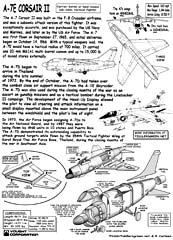

Vought-A7 Corsair - $$4.95
In 1962, the US Navy began preliminary work on the A7 Corair, a replacement for the A-4 Skyhawk only with greater range and payload. Typical of US Government DOD thriftyness, particular emphasis was placed on accurate delivery of weapons to 'reduce the cost per target.' War is OK. Trashed environment OK too. A few million killed or displaced even ok. As long as it's cost effective !! Incoming Shoe
Ling-Tempco-Vought A-7 Corsair II
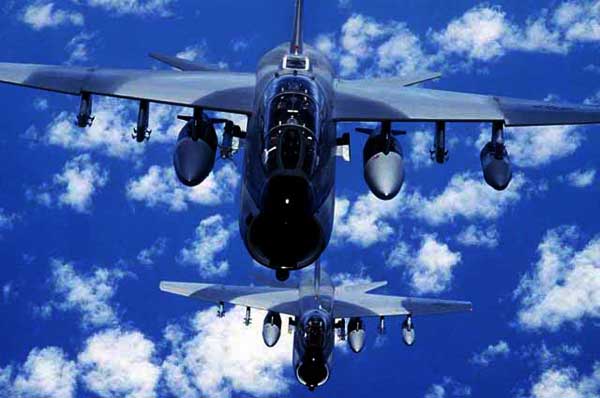
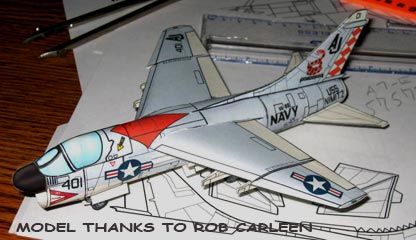 The Vought A-7 Corsair was a light tactical attack air craft that
owes its ancestry to the company's earlier F-8 Crusader. However,
the Corsair is smaller and shorter than its fighting parent.
The Vought A-7 Corsair was a light tactical attack air craft that
owes its ancestry to the company's earlier F-8 Crusader. However,
the Corsair is smaller and shorter than its fighting parent.
In 1965, Vought designers took the basic layout of the "Gunfighter"
F-8U Crusader, chopped the speed, hung up to 15,000 pounds of ordinance
under its wings, and added a revolutionary navigation and aiming
system. It was a more conventional aircraft without the innovative
variable-incidence wing of the A-8. The prototype flew in September
1965 with deliveries to the Navy starting the following year.
When the The USAF saw how perfectly fitted to Vietnam operations
the A-7 was, they ordered their own which was the 'D" version. The
A-7's pinpoint accuracy and long range kept it a valuable asset
into the 90s . It was phased out after the first Gulf War.
It was known as the "Fruitfly" among the Navy A-6 Intruder squadrons who shared deck/hangar space with them in the Carrier Wings of the 70s 80s and 90s. SLUF to everyone else. Short Little Ugly Fella. It took the X-32 to reinvent UGLY, and take it to a new level, but it took it's initial cues from the A-7. Back when the Air Force flew them, they called every armed single seater a "fighter". (This never fooled anyone.) The A-7 had a nice roll rate compared to the Crusader, owing to the A-7's ailerons, which the F-8 lacked.
Beautiful job on this one. The quality is really jumping up.
From 1967 to 1969 I was employed by LTV, I worked on the empennage section of almost all of the A-7's built at the plant. Was nice to see the aircraft again and now I can build the whole aircraft. Oliver A Pettit
Hello, thanks for the A7 Corsair, it would make a brilliant foamy. Ray G.
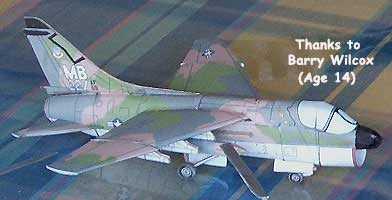
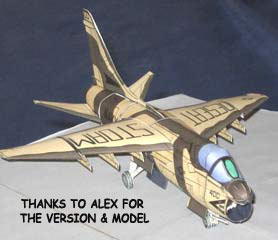 |
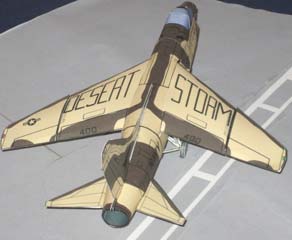 |
This version is included in the A7 Corsair model folder compliments of Alex Costenoble. The markings were taken from the reference photo Alex included below.
|
|
Vought A-7 Corsair II:
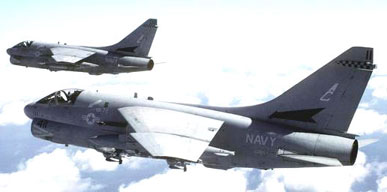
The A-7D is a single-seat, tactical close air support aircraft. Although designed primarily as a ground attack aircraft, it also has limited air-to-air combat capability. It was derived from the basic A-7 originally developed for the U.S. Navy. The first A-7D made its initial flight on April 5, 1968, and deliveries of production models began on Dec. 23, 1968. When A-7D production ended in 1976, 459 had been delivered to the U.S. Air Force.
The A-7D began to arrive in Thailand during the late summer of 1972. By the end of October, the A-7D had taken over the combat close air support mission from the A-1E Skyraider. The A-7D was also used during the closing months of the war as an escort on gun ship missions and as a tactical bomber during the Linebacker II campaign. The development of the Head-Up Display allowed the pilot to view all steering and attack information on a small display mounted above the main instrument panel between the windshield and the pilot's line of sight.
In 1973, the Air Force began assigning A-7Ds to the Air National Guard, and by 1987 they were being flown by ANG units in 10 states and Puerto Rico. The A-7D demonstrated its outstanding capability to attack ground targets while flown by the 354th Tactical Fighter Wing at Korat Royal Thai Air Force Base, Thailand, during the closing months of the war in Southeast Asia. The Corsair II achieved its precise accuracy with the aid of an automatic electronic navigation and weapon delivery system.
| Designation:
A-7D Corsair II Manufacturer: LTV Country: United States Service Date: 1968 Type: Close Air-Support Crew: 1 |
PERFORMANCE Powerplant: 1 x Allison TF41 turbofan engine providing 14,250 lbs of thrust. Max Speed: 663 mph Max Range: 3,044 miles Service Ceiling: 33,500 ft |
| DIMENSIONS Length: 46 ft 1 in Wingspan: 38 ft 8 in Height: 16 ft 1 in Weight (Empty): NA Weight (Loaded): 39,325 lbs |
ARMAMENT 1 x M61A1 20mm rapid-fire cannon 15,000 lbs of mixed ordinance |
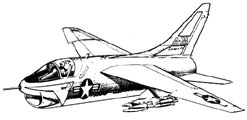 Although cosmetically similar to the F-8 Crusader, the A7 Corsair II
is in fact a completely distinct aircraft with a very different mission.
Replacing the A-4 Skyhawk in 1967 as the Navy's primary light bomber, the
Corsair II flew over 90,000 combat sorties over Vietnam and saw intensive
use throughout its final deployment as part of Operation Desert Storm.
De-navalized versions served as subsonic tactical fighters with the Air
Force and Air National Guard from 1965 to 1993.
Although cosmetically similar to the F-8 Crusader, the A7 Corsair II
is in fact a completely distinct aircraft with a very different mission.
Replacing the A-4 Skyhawk in 1967 as the Navy's primary light bomber, the
Corsair II flew over 90,000 combat sorties over Vietnam and saw intensive
use throughout its final deployment as part of Operation Desert Storm.
De-navalized versions served as subsonic tactical fighters with the Air
Force and Air National Guard from 1965 to 1993.
On 11 February 1964 the US Navy named the former LTV Aerospace Corporation winner of a design competition for a single-seat light attack aircraft. The requirement was for a subsonic aircraft able to carry a greater load of non-nuclear weapons than the A-4E Skyhawk.
To keep costs to a minimum and speed delivery it was stipulated by the USN that the new aircraft should be based on an existing design; the LTV design study was based therefore, on the F-8 Crusader. An initial contract to develop and build three aircraft, under the designation A-7A was made on 27 September 1965.
DESIGN FEATURES:
Cantilever high-wing monoplane. Wing section NACA 65A007. Anhedral
5 degrees. Incidence -1 degree. Wing sweep back at quarter-chord
35 degrees. Outer wing sections fold upward for carrier parking
and, in the A-7H, to allow best utilization of revetments at combat
airfields. One-piece all-moving tailplane, swept back 45 degrees
at quarter-chord and set at dihedral angle of 5 degrees 25'.
FLYING CONTROLS:
Plain sealed inset aluminum ailerons, outboard of wing fold,
are actuated by fully triplicated hydraulic system. Leading-edge
flaps. Large single-slotted trailing-edge flaps. Spoiler above
each wing forward of flaps. Tailplane is operated by triplicated
hydraulic systems, and the rudder powered by two systems.
STRUCTURE:
All-metal multi-spar structure with integrally stiffened aluminum
alloy upper and lower skins. The fuselage is an all-metal semi-monocoque
structure. Large door-type ventral speed-brake under centre-fuselage.
The tail unit consists of a large vertical fin and rudder, swept
back 44.28 degrees at quarter-chord.
LANDING GEAR:
Hydraulically retractable tricycle type, with single wheel on
each main unit and twin-wheel nose unit. Main wheels retract forward
into fuselage, nose wheels aft. Main wheels and tires size 28 x
9-12; nose wheels and tires size 22 x 5.50. Nose gear launch bar
for carrier catapulting. Sting-type arrester hook under rear fuselage
for carrier landings, emergency landings or aborted take-offs.
Anti-skid brake system.
POWER PLANT:|
 One Allison TF41-A-2 (Rolls-Royce Spey) non-after burning turbofan
engine, rated at 15,000 lb st. The A-7E has a pneumatic starter
requiring ground air supply; A-7H, TA-7H and A-7K engines have
self-start capability through the medium of battery-powered electric
motor that actuates a small gas turbine engine (jet fuel starter),
which in turn, starts the main engine through the gearbox. The
engine has self-contained ignition for start/air start, automatic
relight and selective ignition. Integral fuel in tanks in wings
and additional fuselage tanks. Maximum internal fuel 1500 US gallons.
Maximum external fuel 1200 US gallons.
One Allison TF41-A-2 (Rolls-Royce Spey) non-after burning turbofan
engine, rated at 15,000 lb st. The A-7E has a pneumatic starter
requiring ground air supply; A-7H, TA-7H and A-7K engines have
self-start capability through the medium of battery-powered electric
motor that actuates a small gas turbine engine (jet fuel starter),
which in turn, starts the main engine through the gearbox. The
engine has self-contained ignition for start/air start, automatic
relight and selective ignition. Integral fuel in tanks in wings
and additional fuselage tanks. Maximum internal fuel 1500 US gallons.
Maximum external fuel 1200 US gallons.
ACCOMMODATION:
Pilot on McDonnell Douglas Escapade rocket-powered ejection system.
Complete with US Navy life support system on the A-7E/H. Escape
system provides a fully inflated parachute three seconds after
sequence initiation; positive seat/man separation and stabilization
of the ejected seat and pilot. Boron carbide (HFC) cockpit armour.
AVIONICS: AND EQUIPMENT:
The navigation/weapon delivery system is the heart of the A-7E/H
light attack aircraft. It performs continuously the computations
needed for greatly increased delivery accuracy, and for maneuvering
freedom during navigation to a target and the attack, weapon release,
pull up, and safe return phases of the mission. The system not
only provides the pilot with a number of options during the navigation
and weapon delivery, but also relieves him of much of his workload.
The AN/ASN-91(V) navigation/weapon delivery computer is the primary element of the system, in constant 'conversation' with basic electronic sensors, and computes and displays continuously present position, using computed position and stored data to calculate navigation and weapon delivery solutions, and monitors the reliability of data inputs and outputs. An AN/ASN-90(V) inertial measurement set is the basic three-axis reference system for navigation and weapon delivery. AN/APN-190(V) Doppler measures ground speed and drift angle.
AN/APQ-126(V) forward-looking radar provides pilot with 9 modes of operation; air-to-ground ranging; terrain-following; terrain-avoidance; ground mapping, shaped beam; ground mapping, pencil beam; beacon cross-scan terrain-avoidance; cross-scan ground mapping, pencil; TV; and Shrike integrated display system. AN/AVQ-7(V) HUD receives and displays computed attack, navigation and landing data from the tactical computer; aircraft performance data from flight sensors; and discrete signals from various aircraft systems.
ARMAMENT:
A wide range of stores, to a total weight of more than 15,000
lb, can be carried on six underwing pylons and two fuselage weapon
stations, the latter suitable for Sidewinder air-to-air missiles.
Two outboard pylons on each wing can accommodate a load of 13500
lb. Inboard pylon on each wing can carry 2500 lb. Two fuselage
weapon stations, one in each side, can each carry a load of 500
lb. Weapons include air-to-air and air-to-ground (anti-tank and
anti-radar missiles); electro-optical (TV) and laser-guided weapons;
general purpose bombs; bomblet dispensers; rockets; gun pods;
and auxiliary fuel tanks. In addition, an M61A-1 Vulcan 20 mm
cannon is mounted in the port side of the fuselage. This has a
1000 round ammunition storage and selected firing rates of 4000
or 6000 rds/min. Strike camera in lower rear fuselage for damage
assessment.
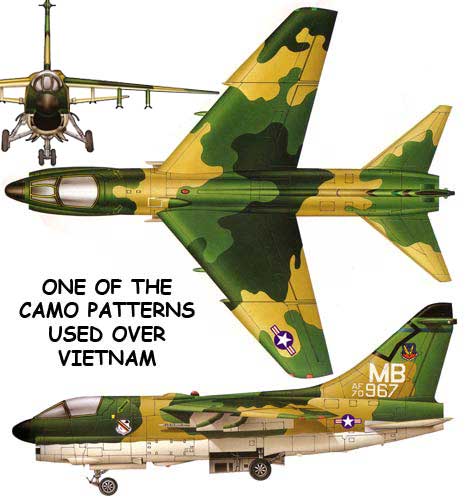
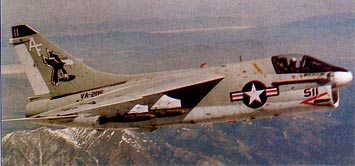
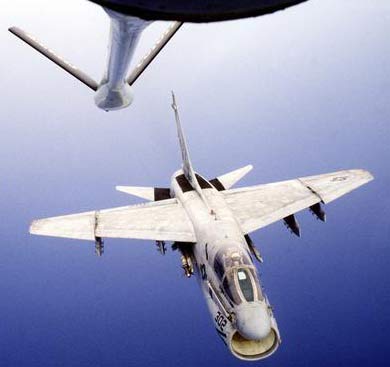
In May 1964, a design proposal by the Chance Vought Corporation was accepted by the Navy as the replacement for the A4D Skyhawk. The first A-7A with an 11,350 lb thrust Pratt and Whitney engine flew in September 1965, and was introduced into Vietnam combat operations in December 1967 where it and subsequent models proved to be one of the most effective close support and strike aircraft used by the Navy in that conflict. Engine thrust was increased to 12,200 lbs in the A-7B with an advanced P&W engine, and ultimately to 14,250 lbs in the A-7E with the Allison-built Rolls-Royce Spey engine utilized by the USAF in their version of the Corsair II (the A-7D). Sixty early A-7B/A-7E airframes were converted to a two-seat advanced trainer derivative with full operational capability and designated as the TA-7C.
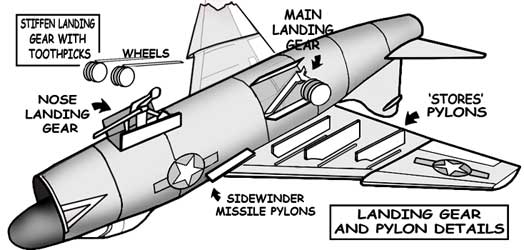
The A-7E (whose procurement ended in 1983) incorporated a greatly improved
avionics installation including heads-up display, an M-61 multi-barrel cannon,
an improved hydraulic system and anti-skid brakes. At the peak of utilization,
22 Navy squadrons were equipped with the A-7E. Transition of some of these
units to the F/A-18 Hornet began in 1987. The last of 850 A-7s were retired
from the Navy's inventory following participation in Desert Storm combat operations.
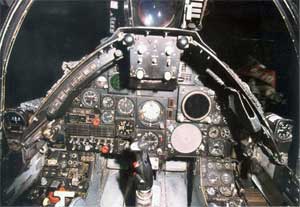 |
Cockpit of the Vought A-7 Corsair. |
Specifications
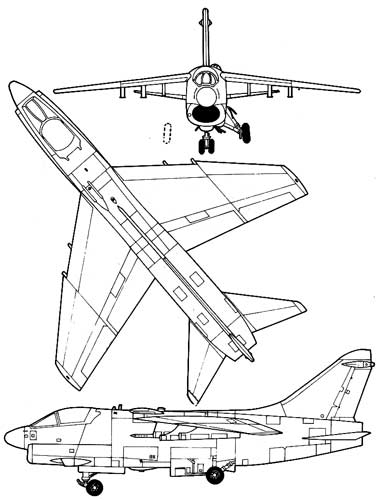 |
Length: 46 ft 1.5 in Wingspan: 38 ft 9 in Height: 16 ft 0.75 in Wing area: 375 ft² Airfoil: NACA 65A007 root and tip Empty weight: 19,915 lb Loaded weight: 29,040 lb Max takeoff weight: 42,000 lb Powerplant: 1× Allison TF41-A-1 turbofan, 14,500 lbf Maximum fuel capacity: 1,338 US gal or 10,200 lb internal Performance Maximum speed: 698 mph at sea level Cruise speed: 535 mph Range: 2,280 mi internal fuel only Combat radius: 715 mi Ferry range: 2,860 mi with 4× 300 gal external tanks Service ceiling: 42,000 ft Rate of climb: 15,000 ft/min Wing loading: 77.4 lb/ft² Thrust/weight: 0.50 Armament Guns: 1× 20 mm (0.787 in) M61 Vulcan gatling gun with 1,030 rounds Hardpoints: 6× under-wing plus 2× fuselage pylon stations (for mounting AIM-9 Sidewinder AAMs only) holding up to 20,000 lb (9,080 kg) of payload: Rockets: 4× LAU-5003 rocket pods (each with 19× CRV7 70 mm rockets) Missiles: Air-to-air missiles: 2× AIM-9 Sidewinder Air-to-surface missiles: 2× AGM-45 Shrike Anti-radiation missile (ARM); or 2× AGM-62 Walleye TV-guided Glide bomb; or 2× AGM-65 Maverick; or 2× AGM-88 HARM; or 2× GBU-15 electro-optically guided Glide bomb Bombs: Up to 30× 500 lb Mark 82 bombs or any combination of the following; Mark 80 series of unguided bombs (including 3 kg and 14 kg practice bombs) Paveway series of laser-guided bombs Up to 4× B28 nuclear bomb/B57 nuclear bomb/B61 nuclear bombs |
A-7 Corsair YouTube video
Extensive and informative documentary (runtime of 44 minutes)



